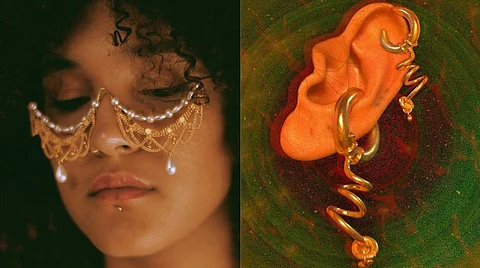
- HOMEGROWN WORLD
- #HGCREATORS
- #HGEXPLORE
- #HGVOICES
- #HGSHOP
- CAREERS
- ABOUT US
- CONTACT US

Inspired by the duality of her own diasporic identity, designer Ayesha Sureya crafts 3D jewellery that merges both traditional and contemporary motifs. The designs offer some function beyond aesthetics and engage with the wearer on a more personal level. Exploring her cultural identity through the use of symbolism, Ayesha helps draw connections between jewellery and the self; introspecting the formality of adornment, and the "narrative of personal materials and objects in a post-colonial world".
The young creative graduated from the Jewellery Design course at Central Saint Martins, London in 2018. Ever since then, she has been experimenting with unique themes that resonate with the ethos of South Asia and are relevant to young consumers who wish to push the boundaries of fashion. Often evoking mythology and native narratives through an intricate design language, Sureya reflects on her own tangled identity by blending conflicting worlds, hence resulting in a more global approach that remains rooted in her heritage.
Her recent collection, ‘Devas’, communicates these distinct concepts through the use of metals and 3D artworks. The artist derives inspiration from the divinity of many indigenous icons that are represented through hyper realistic details in design. The fluidity and colour stories are also reminiscent of these origins. The pieces provide a creative synthesis of religious ideologies and themes using modern techniques. Furthermore, these they mimic the lines of traditional sculptures and art pieces, with undertones and influences that are almost surreal. Ayesha intends to create a new mythology that enables communication, and relates to all individuals; going beyond restrictive identities.
As a South Asian designer, how does the artistic heritage of the region inspire your designs?
So much of what inspires me in my work and particularly my references come from my own roots in India.
In my 'Devas' collection, Hindu deities are depicted with multiple hands in various mudras, wielding weapons or material symbols of their godly powers - a visual interpretation of their otherworldly/transformative power and multifaceted nature. This visual dialogue is incredibly impactful and recognisable in the retelling of these as divine motifs. The sequencing of the mudras becomes a form of non-verbal storytelling, and when worn invites the wearer to reinterpret its symbolism for a personal catharsis in embodiment.
How do you manage to blend two distinct identities from you diasporic experience into these designs?
I’ve just embarked on the journey of a lifetime with a friend from India. The very first trip in my motherland has been somewhat a homecoming, especially after a series of displacements between India, East Africa and London in my ancestry. Holistically in my work, to balance the symbolic duality in the conflicting and social imposed pressures of my own existence as an Indian Brit, including the collective histories and myths; I aim to reappropriate South Asian stereotypes and taboos, to democratise and satirise this empirical connection.
I find significance in conceptualising Indian traditions and identity which use domestic (found and inherited), low-budget materials to evoke the message of ‘homemade’ throughout; to create conversations around jewellery that questions class, value and sentiment; and ultimately reflect the cacophony within the diaspora mind searching for meaning in fragments of myth, modernity, family, and geography.
Explore her digital designs as well as her most recent collections here.
If you enjoyed reading this, here's more from Homegrown:
A Concept Store In Delhi Is Combining Homegrown Slow Fashion & Artisanal Food
How A Women-Led Brand From A Small Town In Uttarakhand Is Pioneering Cultural Sustainability
3rd Migration Creates Artisanal Clothing Inspired By South Asian Heritage & British Subcultures
